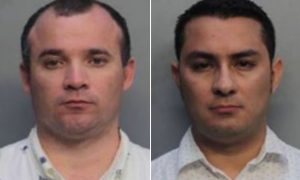Guinness World Records has officially recognized DARPA’s Terahertz Electronics program for creating the fastest solid-state amplifier integrated circuit ever measured. The ten-stage common-source amplifier operates at a speed of one terahertz (1,000,000,000,000 Hz), or one trillion cycles per second — 150 billion cycles faster than the existing world record of 850 gigahertz set in 2012.
“This breakthrough could lead to revolutionary technologies such as high-resolution security imaging systems, improved collision-avoidance radar, communications networks with many times the capacity of current systems and spectrometers that could detect potentially dangerous chemicals and explosives with much greater sensitivity,” said Dev Palmer, DARPA program manager.
Developed by Northrop Grumman Corporation, the Terahertz Monolithic Integrated Circuit (TMIC) exhibits power gains several orders of magnitude beyond the current state of the art, using a super-scaled 25 nanometer gate-length. Gain, which is measured logarithmically in decibels, similar to how earthquake intensity is measured on the Richter scale, describes the ability of an amplifier to increase the power of a signal from the input to the output. The Northrop Grumman TMIC showed a measured gain of nine decibels at 1.0 terahertz and 10 decibels at 1.03 terahertz. By contrast, current smartphone technology operates at one to two gigahertz and wireless networks at 5.7 gigahertz.
“Gains of six decibels or more start to move this research from the laboratory bench to practical applications — nine decibels of gain is unheard of at terahertz frequencies” said Palmer. “This opens up new possibilities for building terahertz radio circuits.”
For years, researchers have been looking to exploit the tremendously high-frequency band beginning above 300 gigahertz where the wavelengths are less than one millimetre. The terahertz level has proven to be somewhat elusive though, due to a lack of effective means to generate, detect, process and radiate the necessary high-frequency signals.
Current electronics using solid-state technologies have largely been unable to access the sub-millimetre band of the electromagnetic spectrum due to insufficient transistor performance. To address the “terahertz gap,” engineers have traditionally used frequency conversion — converting alternating current at one frequency to alternating current at another frequency — to multiply circuit operating frequencies up from millimetre-wave frequencies. This approach, however, restricts the output power of electrical devices and adversely affects signal-to-noise ratio. Frequency conversion also increases device size, weight and power requirements.
DARPA has made a series of strategic investments in terahertz electronics through its HiFIVE, SWIFT and TFAST programs. Each program has built on the successes of the previous one, providing the foundational research necessary for frequencies to reach the terahertz threshold.
Source: Futuretimeline.net

















































































































































































































































![[Video] Chicago Police Officers Caught On Video Telling Two Black Men "We Kill Mother F**kers"](https://earhustle411.com/wp-content/uploads/2018/07/evil-cop-3-300x180.jpg)
![[Video] Chicago Police Officers Caught On Video Telling Two Black Men "We Kill Mother F**kers"](https://earhustle411.com/wp-content/uploads/2018/07/evil-cop-3-80x80.jpg)












![[Video] White Woman Calls The Cops On Black Real Estate Investor, Cops Threaten To Arrest Her For Harassing Him](https://earhustle411.com/wp-content/uploads/2018/05/nosy-neighbor-300x180.png)
![[Video] White Woman Calls The Cops On Black Real Estate Investor, Cops Threaten To Arrest Her For Harassing Him](https://earhustle411.com/wp-content/uploads/2018/05/nosy-neighbor-80x80.png)


![White Scientist Says The Black Community Is Being Targeted By The Medical System, They Are Deliberatly Being Poisoned [Video]](https://earhustle411.com/wp-content/uploads/2016/05/mike-adams-300x180.jpg)
![White Scientist Says The Black Community Is Being Targeted By The Medical System, They Are Deliberatly Being Poisoned [Video]](https://earhustle411.com/wp-content/uploads/2016/05/mike-adams-80x80.jpg)








![Teenage Girl Shot In Her Stomach Three Times But Took Time To Post To Facebook [ Video]](https://earhustle411.com/wp-content/uploads/2016/02/Gangster-chick-300x180.jpg)
![Teenage Girl Shot In Her Stomach Three Times But Took Time To Post To Facebook [ Video]](https://earhustle411.com/wp-content/uploads/2016/02/Gangster-chick-80x80.jpg)







